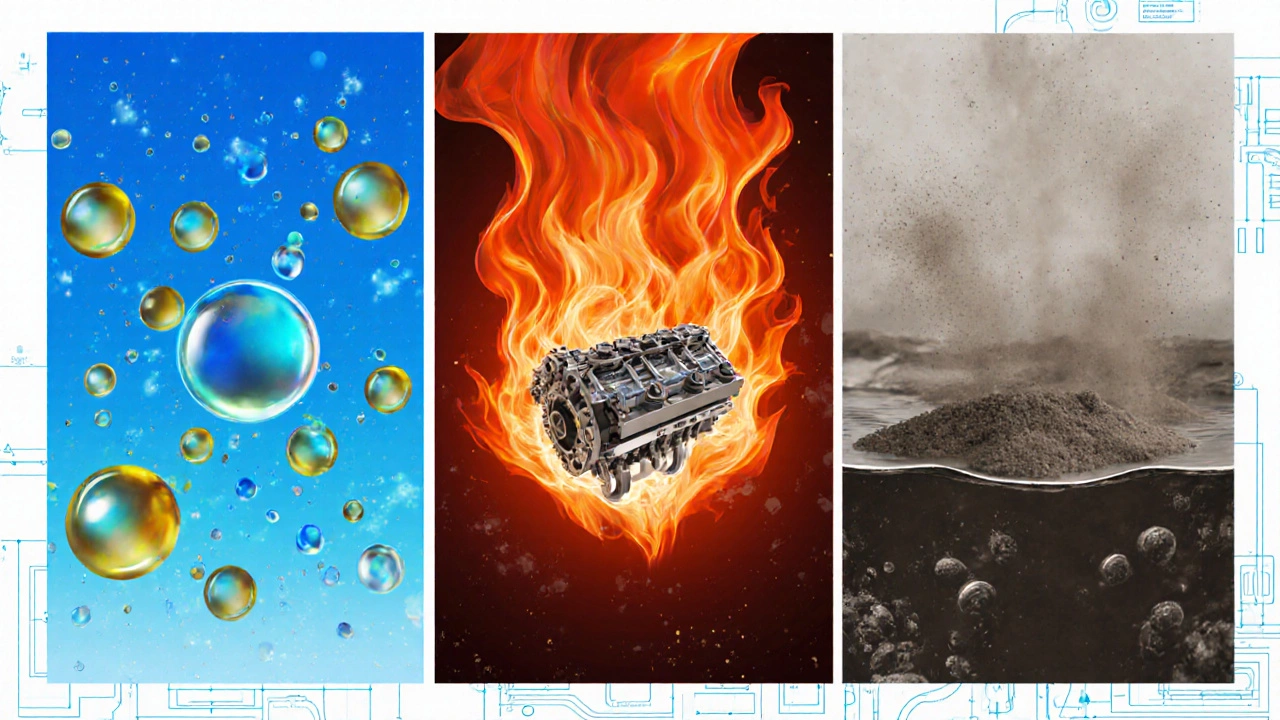Oil Change Interval Calculator
Enter Your Oil Change Details
Recommendation
Enter your details above to get a personalized recommendation.
Note: For best results, also consider your vehicle's oil-life monitoring system.
Based on manufacturer recommendations and real-world data
Key Takeaways
- Engine oil can last anywhere from 3,000 miles to 15,000 miles depending on oil type, driving conditions, and vehicle make.
- Synthetic oil usually outlasts conventional oil because it resists heat and oxidation better.
- Modern oil‑life monitoring systems give a more accurate picture than mileage‑only schedules.
- Regular oil analysis can reveal hidden problems before they become costly repairs.
- Changing the oil filter at every oil change is essential for protecting the oil’s longevity.
When it comes to keeping your car running smooth, engine oil the lubricant that reduces friction between moving parts inside the engine is the star player. Understanding how long engine oil lasts can save you time, money, and a lot of hassle down the road.
Why Oil Doesn’t Last Forever
Oil breaks down because of three main mechanisms: oxidation, thermal cracking, and contaminant buildup. Oxidation occurs when oxygen molecules react with oil molecules, forming acids and sludge. Thermal cracking happens at high temperatures-think stop‑and‑go traffic in summer-splitting long‑chain hydrocarbons into shorter, less effective ones. Lastly, dust, metal particles, and fuel residues accumulate, turning the oil into a gritty slurry.
Each of these processes reduces the oil’s ability to lubricate, cool, and clean the engine. When the oil can’t do its job, friction rises, wear accelerates, and you risk a costly engine failure.
Factors That Influence Oil Longevity
Not every driver gets the same mileage out of a quart of oil. Here are the biggest variables:
- Oil type: Synthetic blends, full‑synthetic, and conventional oil each have different resistance to heat and oxidation.
- Viscosity grade: A 5W‑30 oil behaves differently at low‑temp start‑up than a 10W‑40, affecting how quickly it degrades in cold climates.
- Driving style: Short trips that never let the engine reach operating temperature cause moisture buildup, shortening oil life.
- Environment: Dusty roads, extreme heat, and high humidity all accelerate contaminant accumulation.
- Engine design: Modern engines with tighter tolerances and higher compression ratios often need higher‑quality oil.
- Oil filter quality: A high‑flow oil filter captures particles before they circulate through the engine helps preserve oil chemistry longer.
Typical Change Intervals by Oil Type
Manufacturers still list mileage‑based intervals on the owner’s manual, but real‑world data tells a more nuanced story.
| Oil Type | Typical Mileage Interval | Typical Time Interval |
|---|---|---|
| Conventional | 3,000 - 5,000 mi | 3 months |
| Semi‑synthetic (synthetic blend) | 5,000 - 7,500 mi | 6 months |
| Full‑synthetic | 7,500 - 15,000 mi | 12 months |
These ranges assume normal driving conditions and timely filter replacement. Extreme conditions (towing, racing, desert heat) can halve the intervals.

Synthetic vs. Conventional: A Direct Comparison
| Attribute | Full‑Synthetic | Conventional |
|---|---|---|
| Typical lifespan (miles) | 10,000 - 15,000 | 3,000 - 5,000 |
| Cost per quart (USD) | $8 - $12 | $4 - $6 |
| Heat resistance | High | Medium |
| Oxidation resistance | Excellent | Fair |
| Recommended for high‑performance engines | Yes | No |
While synthetic oil carries a higher price tag, the extended service interval often offsets the extra cost, especially on high‑mileage vehicles.
Using Oil‑Life Monitoring Systems
Many new cars feature an Oil Life Monitoring (OLM) system that calculates remaining oil life based on engine temperature, RPM, and driving cycles. These systems use algorithms derived from the vehicle’s API American Petroleum Institute specifications that classify oil performance and manufacturer‑specific data (e.g., VW 504 00/507 00).
When the OLM shows 15 % or less, it’s time to plan a change, even if you haven’t hit the mileage target. Ignoring the warning can lead to oil that’s chemically exhausted while still looking clean.
When to Change Oil Early
Even the best oil can fail under certain conditions. Look out for these red flags:
- Dark, gritty oil on the dipstick (indicates particle contamination).
- Engine knocking or increased fuel consumption.
- Oil pressure warning light.
- Frequent short trips that don’t allow the engine to reach normal operating temperature.
If any of these appear, schedule a change immediately, regardless of the mileage count.

DIY Oil Analysis: A Proactive Approach
Sending a small sample of used oil to an accredited lab can reveal wear metals (iron, copper), moisture levels, and additive depletion. Results are often returned with a “condition” rating (good, marginal, poor). A “marginal” rating after 5,000 mi on conventional oil suggests it’s time to switch to a synthetic blend.
Many auto parts stores offer kits for under $20, and the insight can prevent a catastrophic engine rebuild later on.
Practical Checklist for Your Next Oil Change
- Confirm the oil type recommended by the manufacturer (check the owner's manual or a reliable database).
- Verify the correct viscosity grade for your climate (e.g., 5W‑30 for temperate zones, 0W‑20 for colder regions).
- Replace the oil filter with a high‑efficiency model that matches the oil’s specifications.
- Reset the OLM or note the mileage you’ve just covered.
- Inspect the dipstick for color, clarity, and any metallic particles.
- Consider taking a sample for lab analysis if the oil looks abnormal.
Bottom Line
Oil lifespan isn’t a one‑size‑fits‑all number. It’s a blend of oil chemistry, engine design, driving habits, and environment. By paying attention to the factors above and using modern monitoring tools, you can fine‑tune your change schedule for maximum protection and minimum expense.
How often should I change my engine oil?
For conventional oil, most experts recommend every 3,000-5,000 mi or three months, whichever comes first. Synthetic blends can stretch to 7,500 mi, and full‑synthetic often lasts 10,000-15,000 mi or up to a year.
Will my car’s oil‑life monitor replace regular oil changes?
The monitor helps you time changes more accurately, but it’s not a free pass. You still need to respect the manufacturer’s minimum interval and replace the filter each time.
Can I mix synthetic and conventional oil?
Mixing is generally safe, but it defeats the purpose of using a high‑performance oil. Stick to the type recommended for your engine.
What are the signs that my oil is breaking down early?
Dark, gritty oil, a strong burnt smell, low oil pressure warnings, and increased engine noise are all red flags that the oil has lost its protective qualities.
Is an oil analysis worth the cost?
For most drivers, a yearly analysis can catch wear metals and moisture before they cause damage. The $20‑$30 price is small compared to a potential engine rebuild.






